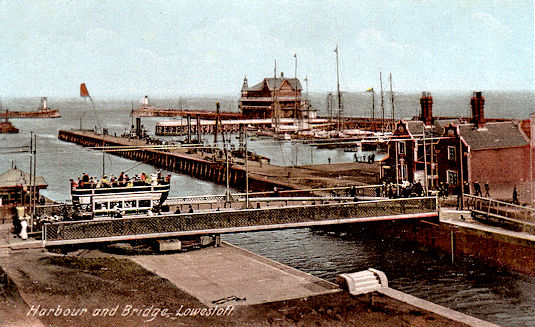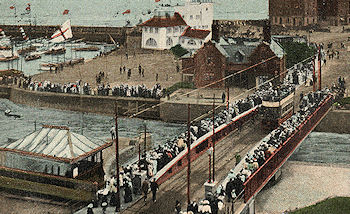

This is a postcard in the Jay Em Jay series of Jackson & Sons of Grimsby. It was published around 1904 and shows the swing bridge used by the Lowestoft Corporation Tramways. The smaller view (below) is extracted from a Valentine's card and indicates how busy the bridge footpaths could get. Lowestoft operated a 3ft 6in gauge four-mile-long tramway from 1903 until 1931, and which has been described elsewhere (see Postcard).
 The major engineering feature of the tramway was the swing bridge over the canal that joined the North Sea to the Inner Harbour, Lake Lothing and Oulton Broad, with navigable connections via the Broads to Norwich and Yarmouth. The canal was built in 1830, as was the first harbour bridge, a fixed structure. In the 1840s the first swing bridge was installed. The swing bridge used by trams was built by the Great Eastern Railway in 1897, replacing the earlier one. It was 116 ft long and 22ft 6in wide, weighing 16 tons as originally built. It was worked by hydraulic power, first slightly lifting and then swinging in a clockwise direction. The footways at each side were separated and cantilevered from the roadway. The small building at the left end of the bridge in our view, was the observation and control cabin. The substantial building in the background centre was the South Pier Pavilion of 1891, demolished in 1954.
The major engineering feature of the tramway was the swing bridge over the canal that joined the North Sea to the Inner Harbour, Lake Lothing and Oulton Broad, with navigable connections via the Broads to Norwich and Yarmouth. The canal was built in 1830, as was the first harbour bridge, a fixed structure. In the 1840s the first swing bridge was installed. The swing bridge used by trams was built by the Great Eastern Railway in 1897, replacing the earlier one. It was 116 ft long and 22ft 6in wide, weighing 16 tons as originally built. It was worked by hydraulic power, first slightly lifting and then swinging in a clockwise direction. The footways at each side were separated and cantilevered from the roadway. The small building at the left end of the bridge in our view, was the observation and control cabin. The substantial building in the background centre was the South Pier Pavilion of 1891, demolished in 1954.
In 1903 the corporation laid double-track special low profile tram rails on it and the overhead constructed in aluminium was in one section so that it swung with the bridge. Feeder cables passed below the harbour in iron tubing. For safety when the bridge was open, the overhead on the bridge and that for a short distance on each side was isolated. There were sliding safety barriers and interlocked railway type semaphore signals (installed in 1905), and the tramway was fitted with catch points. For weight reasons only one tram at a time was allowed on the bridge. Two flags, one of which can be seen behind the tram in our view, were raised to indicate when the navigation was not available to shipping.
The bridge was demolished in 1970 after failing the previous year, being replaced two years later by the current bascule bridge which itself in now life-expired and due for upgrade.
![]() Go to Postcard Of The Month Index
Go to Postcard Of The Month Index